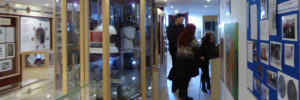The Moravian Church
The Julia and Hans Rausing Building, now part of the Athelstan Museum was formerly a Moravian Church.
The Moravian Church has its origins in what is now the Czech Republic, where Jan Hus (born 1369) began preaching his ‘reformist’ message in Bethlehem Chapel in Prague, Bohemia.
The missionary work of the Moravian church spread around the globe to North and South America, the Arctic, Africa and the Far East.
The first society in the UK was founded in 1740 and then spread to other parts of England. A religious community was started in Malmesbury in 1742 in a converted malt house.
The building on the Museum’s site was built in 1770 and then rebuilt in 1859.
The Moravian Church is organised into Unitary Provinces and there are still about 750,000 members worldwide.
Congregations of the churches are organised into ‘choirs’ for worship and study, according to age, gender and marital status with choral music an important part of their worship.
The motto of the Moravian Church is ‘In essentials, unity; in nonessentials liberty; and in all things, love’.
The church became derelict in the 1990s as a result of a diminished congregation of about six elderly people who were being taken to East Tytherton for services.
The church was sold and there was a sequence of three absentee owners, the condition of the church worsening all the time.
In 2016, Athelstan Museum (see History of the Museum) purchased the building and after a considerable and individual renovation the former church, now called the Julia and Hans Rausing Building, was opened by Her Majesty, The Queen Consort in December 2018.
Its future was to be an arts, educational and cultural centre.
During the project a close relationship was established with the Moravian Church in the British Province in London, who indeed attended the opening ceremony. The ethos of the building with a strong respect for its history was retained and in many cases enhanced.
United Reformed Church, Westport
Malmesbury’s architectural heritage is so dominated by its Abbey that we tend to overlook other buildings of merit. One example is the United Reformed (formerly Congregational) Church in Westport, which is located between St Mary’s Street and West Street, Non-conformist worship in Westport began in 1662 and by the mid-1860s, the congregation had outgrown its chapel and a new church and schoolroom was commissioned. The main financier was Charles Jupe, a Silk Throwster from Mere who, two decades later was to purchase the Silk Mills. The Architect was William Jervis Stent of Warminster (1815-1887). The new Congregational Church was certified and registered for religious worship and solemnisation of marriages on 13th November, 1867. In 1972 it merged with the Presbyterians to become the United Reformed Church.
St. Aldhelm’s Church
St Aldhelm’s Church was founded in 1875 by French priest Francois Larive, who was the first Missionary of St. Francis de Sales to work in England.
The idea of founding a church in Malmesbury was given to him by Captain Charles Goddard Dewell of the 91st Argyllshire Regiment of Foot who was born and raised in Malmesbury. The two met in 1858 while Captain Dewell was posted to the village of Kamptee in India. Dewell had recently been baptised into the Roman Catholic Church after being converted to Catholicism following falling ill while serving in Italy.
He wanted to start a church in his home town, so after much discussion with Father Larive, the two decided to set up a church in Malmesbury. In 1861, Father Larive and Dewell came to Malmesbury, and they decided on a site for the church: Cross Hayes House, which was owned by Dewell.
There were delays with the transfer of the lease of the house, so it did not become available until 1867. It was in that year that Captain Dewell became a lay brother in the Society of Jesus and opened a school, despite fierce local opposition, including from the local member of parliament.
A temporary church was set up on newly purchased adjoining land in 1869, and used until the present church was opened on 1 July 1875. Father Larive dedicated the church to St. Aldhelm who was the patron saint of the town and was the founder and first abbot at the nearby Malmesbury Abbey from 675 to 705.
The site of the old church became St. Joseph’s Primary School, run by and named after the Sisters of St Joseph of Annecy with whom Father Larive had previously worked. The school remained there until 1933 when it moved to its current site on Holloway Hill.




